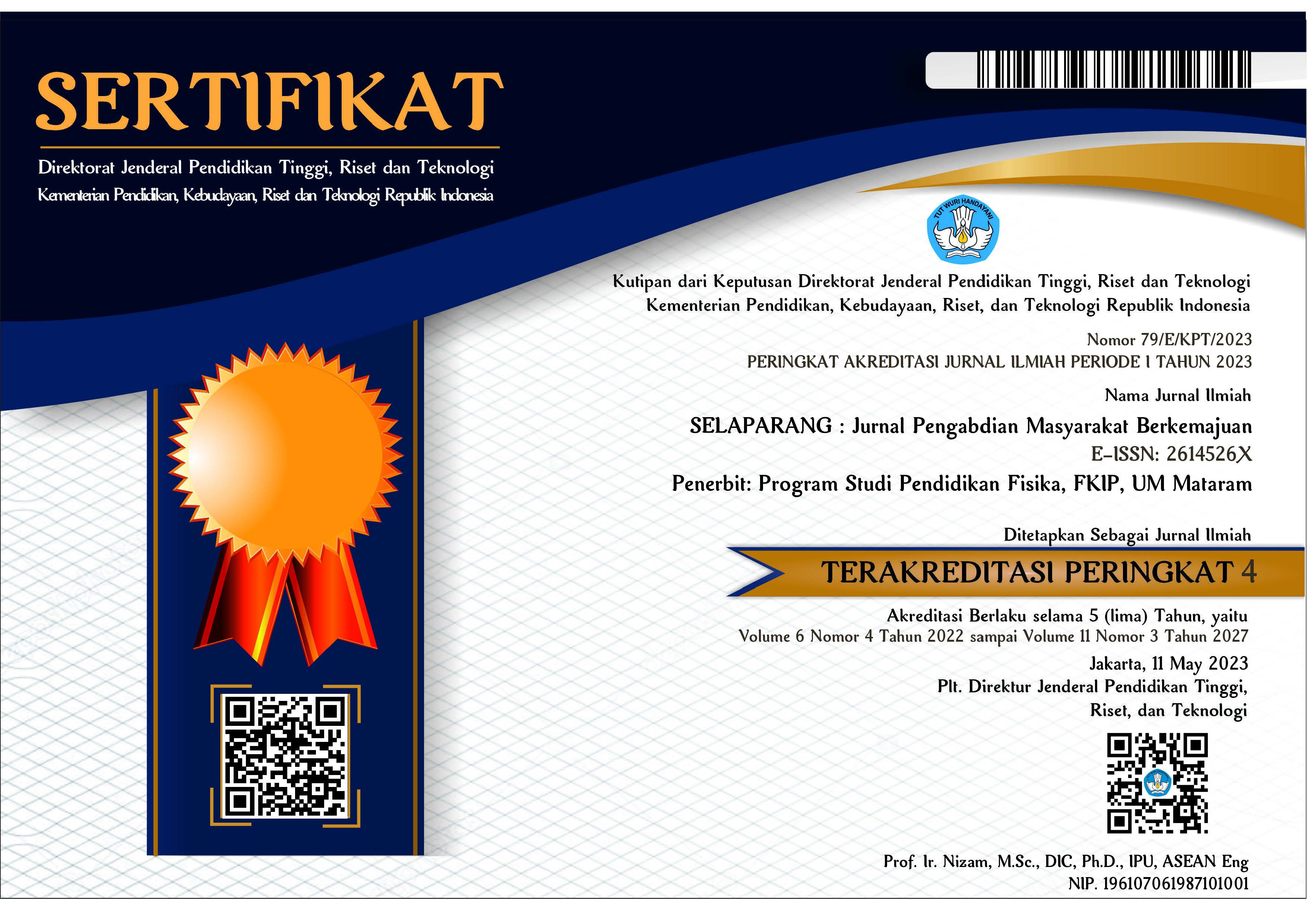Pembentukan pojok herbal dan produk herbal (teh dan sirup) untuk meningkatkan kualitas kesehatan masyarakat di Desa Bengkaung, Kecamatan Batulayar, NTB
Abstract
Abstrak
Desa Bengkaung adalah desa yang terletak di kecamatan Batu Layar, Lombok Barat, Nusa Tenggara Barat. Banyak potensi pada desa Bengkaung yang masih bisa dikembangkan diantaranya adalah sumber daya alam yang berlimpah. Namun, pemanfaatan sumber daya alam ini belum maksimal, yang disebabkan oleh kurangnya pengetahuan masyarakat mengenai manfaat dan pengolahannya. Maka dilakukan pengabdian masyarakat yang berlangsung 2 tahap yaitu seminar terkait pojok herbal dan pelatihan pembuatan teh dan sirup dengan bahan kayu manis, kunyit, temu lawak, asam jawa, kapulaga untuk sediaan sirup serta bangle pada sediaan teh herbal yang berfungsi untuk meningkatkan kesehatan masyarakat. Kegiatan tersebut dilaksanakan pada 25 Oktober 2024 dengan mitra terdiri dari anggota IAI kota Mataram dan kader PKK desa Bengkaung. Adapun materi pelatihan diberikan dengan metode ceramah dan metode praktik. Evaluasi dilakukan dengan cara pemberian pre-test dan post-test, kemudian dianalisis secara kuantitatif. Berdasarkan hasil pre-test dan post-test, diperoleh nilai rata-rata sebesar 60,94 dan 79.37, yang menunjukkan adanya peningkatan pengetahuan mitra terhadap materi penyuluhan yang diberikan. Teh daun salam dan JKP-Bangle dievaluasi dengan pengukuran kadar antioksidan dengan DPPH dan FRAP assay. Hasil analisis menunjukkan bahwa kadar antioksidan the daun salam dan JKP-Bangle dengan FRAP assay memperoleh kadar tertinggi tertinggi nilai masing-masing sebesar 1359.84±13.47 mg GAE/g berat kering dan 396.73±16.79 mg GAE/g berat kering. Aktivitas antioksidan yang tinggi ini mengindikasikan potensi manfaat kesehatan dalam menangkal stres oksidatif yang berhubungan dengan penyakit neurodegeneratif, kardiovaskular, dan diabetes.
Kata kunci: Desa Bengkaung; pojok herbal; tanaman obat; antioksidan.
Abstract
Bengkaung Village is a village located in Batu Layar sub-district, West Lombok, West Nusa Tenggara. There is a lot of potential in Bengkaung Village that can still be developed, including abundant natural resources. However, the utilization of these natural resources has not been maximized, this is caused by a lack of public knowledge regarding their benefits and processing. So community service was carried out which took place in 2 stages, namely seminars related to the herbal corner and training in making tea and syrup using cinnamon, turmeric, ginger, tamarind, cardamom for syrup and bangle preparations, as well as bangles for herbal tea preparations which function to improve health. public. This activity was carried out on 24-26 October 2024 with partners consisting of IAI members from Mataram city and PKK cadres from Bengkaung village. The training material is provided using the lecture method and the Experimental Learning method (direct implementation learning). Evaluation is carried out by giving a pre-test and post-test, then analyzed quantitatively. Based on the results of the pre-test and post-test, an average score of 60.94 and 79.37 was obtained, which indicates an increase in partners' knowledge of the extension material providedrn how to make innovative products from mangosteen fruit so that they can be produced commercially. Thus, in the long term it is expected to increase the income of the Songgon Village residents. Antioxidant levels of bay leaf tea and JKP-Bangle were evaluated using DPPH and FRAP assays. Analysis results showed that the highest antioxidant levels measured by the FRAP assay were 1359.84±13.47 mg GAE/g dry weight for bay leaf tea and 396.73±16.79 mg GAE/g dry weight for JKP-Bangle. This high antioxidant activity indicates potential health benefits in combating oxidative stress associated with neurodegenerative, cardiovascular, and diabetes-related diseases.
Keywords: Songgon Village; herbal corner; medicinal plants; antioxidants.
Keywords
Full Text:
PDFReferences
Aryaeian, N., Shahram, F., Mahmoudi, M., Tavakoli, H., Yousefi, B., & Arablou, T. (2019). The effect of ginger supplementation on some immunity and inflammation intermediate genes expression in patients with active rheumatoid arthritis. Gene, 698(December 2018), 179–185. https://doi.org/10.1016/j.gene.2019.01.048
Arzati, M. M., Mohammadzadeh Honarvar, N., Saedisomeolia, A., Anvari, S., Effatpanah, M., Makhdoomi Arzati, R., Yekaninejad, M. S., Hashemi, R., & Djalali, M. (2017). The effects of ginger on fasting blood sugar, hemoglobin A1c, and lipid profiles in patients with type 2 diabetes. International Journal of Endocrinology and Metabolism, 15(4), 0–6. https://doi.org/10.5812/ijem.57927
Azis, A. (2019). Kunyit (Curcuma domestica Val) sebagai obat antipiretik. Jurnal Ilmu Kedokteran Dan Kesehatan, 6(2), 116–120.
Bayani, F., Muhali, H., Bilad, M. R., Samsuri, T., & Fitriani, H. (2024). Program kemitraan masyarakat: Pelatihan budidaya tanaman obat keluarga masyarakat Desa Bengkaung. Community Partnership Program, 9(2), 399–410.
Badan Pusat Statistik (BPS). (2023). Kecamatan Batu Layar dalam angka.
Dhanik, J., Arya, N., Nand, V., & Dhanik, J. (2017). A review on Zingiber officinale. Journal of Pharmacognosy and Phytochemistry, 6(3), 174–184.
Ebrahimzadeh Attari, V., Ostadrahimi, A., Asghari Jafarabadi, M., Mehralizadeh, S., & Mahluji, S. (2016). Changes of serum adipocytokines and body weight following Zingiber officinale supplementation in obese women: A randomized controlled trial. European Journal of Nutrition, 55(6), 2129–2136. https://doi.org/10.1007/s00394-015-1027-6
Giordano, A., & Tommonaro, G. (2019). Curcumin and cancer. Nutrients, 11(10). https://doi.org/10.3390/nu11102376
Han, A. R., Kim, H., Piao, D., Jung, C. H., & Seo, E. K. (2021). Phytochemicals and bioactivities of Zingiber cassumunar Roxb. Molecules, 26(8), 1–16. https://doi.org/10.3390/molecules26082377
Han, A. R., Lee, E. J., Min, H. Y., Kim, H. R., Lee, S. K., & Seo, E. K. (2003). A potential cytotoxic principle of Zingiber cassumunar. Natural Product Sciences, 9(2), 109–111.
Harefa, D. (2020). Pemanfaatan hasil tanaman sebagai tanaman obat keluarga (TOGA). Madani: Indonesian Journal of Civil Society, 2(2), 28–36. https://doi.org/10.35970/madani.v2i2.233
Hartanti, D., Chatsumpun, N., Sa-Ngiamsuntorn, K., Supharattanasitthi, W., Kitphati, W., & Peungvicha, P. (2023). The pharmacognostic standards, antioxidant and antidiabetic activities, and hepatic safety profile of an Indonesian antidiabetic polyherbal formulation. Indonesian Journal of Pharmacy, 34(1), 65–78. https://doi.org/10.22146/ijp.3243
Indrianingsih, A. W., & Prihantini, A. I. (2018). In vitro antioxidant and α-glucosidase inhibitory assay of Zingiber cassumunar Roxb. AIP Conference Proceedings, 2026(2018). https://doi.org/10.1063/1.5064965
Javid, A. Z., Bazyar, H., Gholinezhad, H., Rahimlou, M., Rashidi, H., Salehi, P., & Haghighi-zadeh, M. H. (2019). The effects of ginger supplementation on inflammatory, antioxidant, and periodontal parameters in type 2 diabetes mellitus patients with chronic periodontitis under non-surgical periodontal therapy: A double-blind, placebo-controlled trial. Diabetes, Metabolic Syndrome and Obesity, 12, 1751–1761. https://doi.org/10.2147/DMSO.S214333
Kandasamy, A., Aruchamy, K., Rangasamy, P., Varadhaiyan, D., Gowri, C., Oh, T. H., Ramasundaram, S., & Athinarayanan, B. (2023). Phytochemical analysis and antioxidant activity of Centella Asiatica extracts: An experimental and theoretical investigation of flavonoids. Plants, 12(20). https://doi.org/10.3390/plants12203547
Leopoldini, M., Russo, N., & Toscano, M. (2011). The molecular basis of working mechanism of natural polyphenolic antioxidants. Food Chemistry, 125(2), 288–306. https://doi.org/10.1016/j.foodchem.2010.08.012
MacDonald, C. (2012). Understanding PAR: A qualitative research methodology. Canadian Journal of Action Research, 13(2), 34–50.
Mesri, M., Esmaeili Saber, S. S., Godazi, M., Roustaei Shirdel, A., Montazer, R., Koohestani, H. R., Baghcheghi, N., Karimy, M., & Azizi, N. (2021). The effects of combination of Zingiber officinale and Echinacea on alleviation of clinical symptoms and hospitalization rate of suspected COVID-19 outpatients: A randomized controlled trial. Journal of Complementary and Integrative Medicine, 18(4), 775–781. https://doi.org/10.1515/jcim-2020-0283
Mustafa, I., & Chin, N. L. (2023). Antioxidant properties of dried ginger (Zingiber officinale Roscoe) var. Bentong. Foods, 12(1), 1–18. https://doi.org/10.3390/foods12010178
Pithayanukul, P., Tubprasert, J., & Wuthi-Udomlert, M. (2007). In vitro antimicrobial activity of Zingiber cassumunar (plai) oil and a 5% plai oil gel. Phytotherapy Research, 21(2), 164–169. https://doi.org/10.1002/ptr.2048
Rujirek, C., Siriwan, O., Siriwan, T., Prachya, K., Ampai, P., & Vichai, R. (2012). Chondroprotective potential of bioactive compounds of Zingiber cassumunar Roxb. against cytokine-induced cartilage degradation in explant culture. Journal of Medicinal Plants Research, 6(39), 5204–5213. https://doi.org/10.5897/jmpr11.1633
Singh, P., & Singh, J. S. (2002). Recruitment and competitive interaction between ramets and seedlings in a perennial medicinal herb, Centella Asiatica. Basic and Applied Ecology, 3(1), 65–76. https://doi.org/10.1078/1439-1791-00085
Tanvir, E. M., Hossen, M. S., Hossain, M. F., Afroz, R., Gan, S. H., Khalil, M. I., & Karim, N. (2017). Antioxidant properties of popular turmeric (Curcuma longa) varieties from Bangladesh. Journal of Food Quality, 2017. https://doi.org/10.1155/2017/8471785
Thepthong, P., Rattakarn, K., Ritchaiyaphum, N., Intachai, S., & Chanasit, W. (2023). Effect of extraction solvents on antioxidant and antibacterial activity of Zingiber montanum rhizomes. ASEAN Journal of Scientific and Technological Reports, 26(3), 1–9. https://doi.org/10.55164/ajstr.v26i3.249309
Verma, R. K., Kumari, P., Maurya, R. K., Kumar, V., Verma, R. B., & Singh, R. K. (2018). A review on medicinal properties of turmeric (Curcuma longa L.). International Journal of Pharmacognosy and Pharmaceutical Sciences, 6(4), 49–53. https://doi.org/10.33545/27067009.2022.v4.i2a.63
Wang, H., Liu, Y., Che, S., Li, X., Tang, D., Lv, S., & Zhao, H. (2024). Deciphering the link: Ferroptosis and its role in glioma. Frontiers in Immunology, 15(January), 1–14. https://doi.org/10.3389/fimmu.2024.1346585
Widiatami, T., Widyawati, M. N., & Admini, A. (2018). Study literature tentang pemberian minuman kunyit asam terhadap tingkat nyeri menstruasi pada remaja putri. Jurnal Kebidanan, 8(2), 139. https://doi.org/10.31983/jkb.v8i2.3743
Wojtunik-Kulesza, K., Oniszczuk, A., & Waksmundzka-Hajnos, M. (2019). An attempt to elucidate the role of iron and zinc ions in development of Alzheimer’s and Parkinson’s diseases. Biomedicine and Pharmacotherapy, 111(December 2018), 1277–1289. https://doi.org/10.1016/j.biopha.2018.12.140
Wong, S. P., Leong, L. P., & Koh, J. H. W. (2006). Antioxidant activities of aqueous extracts of selected plants. Food Chemistry, 99(4), 775–783. https://doi.org/10.1016/j.foodchem.2005.07.058
DOI: https://doi.org/10.31764/jpmb.v9i3.30199
Refbacks
- There are currently no refbacks.

This work is licensed under a Creative Commons Attribution-ShareAlike 4.0 International License.
______________________________________________________
Jurnal Selaparang
p-ISSN 2614-5251 || e-ISSN 2614-526X
EDITORIAL OFFICE:



















